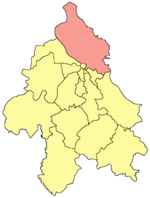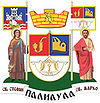Palilula, Belgrade
|
Palilula Палилула |
||
|---|---|---|
| Urban neighborhood and municipality | ||
|
||
 Location of Palilula within the city of Belgrade |
||
 Location of the city of Belgrade within Serbia |
||
| Country |
|
|
| City | Belgrade | |
| Status | Municipality | |
| Settlements | 8 | |
| Government | ||
| • Type | Municipality of Belgrade | |
| • Mun. president | Aleksandar Jovičić (SNS) | |
| Area | ||
| • Total | 447 km2 (173 sq mi) | |
| Population (2011) | ||
| • Total | 170,593 | |
| • Density | 380/km2 (990/sq mi) | |
| Time zone | CET (UTC+1) | |
| • Summer (DST) | CEST (UTC+2) | |
| Postal code | 11000 | |
| Area code(s) | +381(0)11 | |
| Car plates | BG | |
| Website | www |
|
Palilula (Serbian Cyrillic: Палилула, pronounced [pǎlilula]) is an urban neighborhood and one of 17 city municipalities which constitute the city of Belgrade, the capital of Serbia. It has the largest area of all municipalities of Belgrade. The core of Palilula is close to the center of the city, but the municipality also includes sparsely populated land left of the Danube.
Palilula is located east of Terazije in downtown Belgrade. Like most of Belgrade's neighborhoods it has no firm boundaries and is roughly bordered by the Ruzveltova street and the municipality and neighborhood of Zvezdara on the east, the neighborhood of Hadžipopovac in its own municipality on the north, the neighborhood and municipality of Stari Grad and Jevremovac on the northwest (Jevremovac actually belongs to the neighborhood of Palilula, but administratively is part of Stari Grad), and the Tašmajdan and King Alexander Boulevard on the south, bordering the municipality of Vračar. Several small local communities which make up this area had a combined population of 14,896 in 2002.
The neighborhood originated in the first half of the 18th century, when the Habsburg Monarchy occupied northern Serbia 1717–1739. The settlement, built as an outer suburb of Belgrade, was originally named Karlstadt and was known for agriculture and skilled crafts. In the early 19th century, it became overwhelmingly populated by the Serbs. In 1840, villagers of Palilula rejected the regulatory plan of Belgrade, on the basis that projected new streets would be too wide, and later even tried to split from the municipality of Belgrade because of the city government's low funding for the village. However, in the late 19th century Palilula became part of the continuously built-up area of Belgrade. The neighborhood was mostly residential, with commercial facilities closer to the center of Belgrade.
...
Wikipedia

